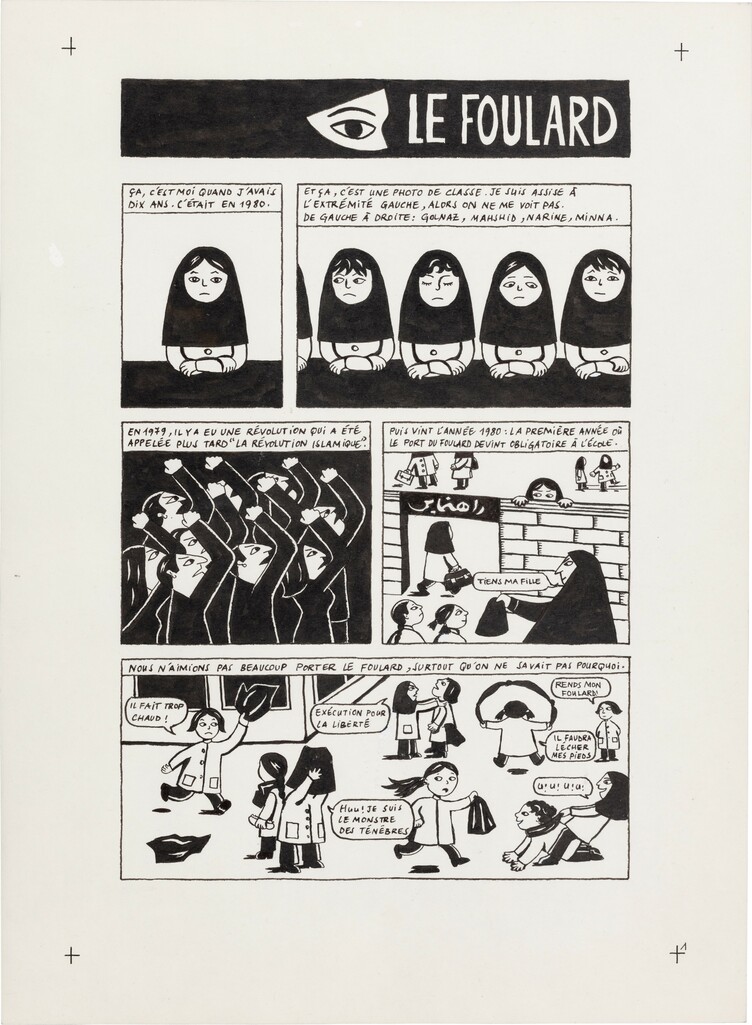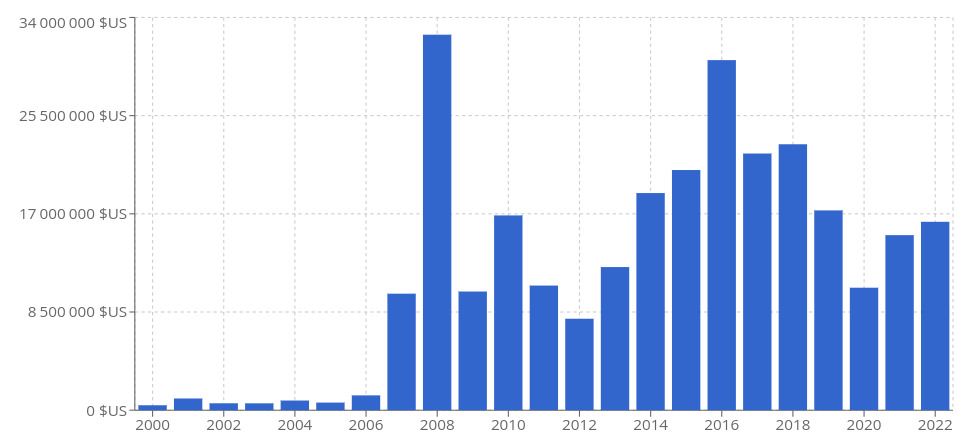Iranian artists: heads up and hair in the wind…
[02 Dec 2022]“When I set out to write my story, I also could not have imagined that its message would be so universal” Marjane Satrapi interview Sotheby’s 2022
In Iran, demonstrator anger is not waning. Indeed, beyond protests regarding the obligation for women to wear a veil, the daily weight of religion and the police violence which led to the death of the young student Mahsa Amini on September 16 (as well as many others), it is the whole politico-economic structure of the regime that is now being questioned. The desire for change is so strong among Iranians that the entire regime of the Islamic Republic of Iran is now targeted. Seven months ago, Marjane SATRAPI (1969), creator of the graphic novel (then animated film) Persepolis – recounting the Iranian revolution of the years 1978/79 – decided to sell the original drawings of the work that made her famous. Their inclusion in a Sotheby’s UK online sale in October coincided providentially with the wind of freedom blowing through the ancient Persian empire.
The Persepolis sale
“I could never have imagined that it (the sale) would be in the context of the incredible scenes we are seeing in Iran today”. In Persepolis, Marjane Satrapi prefigures scenes similar to those currently happening on the streets in Iran where the country erupts into violent protest after women take off their head scarfs and burn them in public.

Marjane SATRAPI, Le Foulard, Persepolis (Original Book Art, page 1)
Satrapi’s scarf drawing fetched indeed the best result in Sotheby’s online sale between October 12 and 25, and a new record for the artist whose works are rare on the secondary market. The first page Persepolis (Original Book Art, page 1) titled “Le Foulard” in French, fetched nearly $46,200. In total, almost all the 44 pages of the first volume, each estimated between $4,500 and $6,500, exceeded their high estimates, generating a total of $665,000!
A comic book published in 4 volumes in the early 2000s by L’Association, Persepolis has sold millions of copies worldwide and has been translated into several languages. After the animated adaptation, co-directed with Vincent Paronnaud in 2007, Perspepolis became a real ‘phenomenon’. The black & white pages drawn with felt pen are the artist’s trademark and the assertive and free graphic style, simultaneously contemporary and timeless, has become ‘cult’. “Iconic and deeply symbolic, sometimes reminiscent of Persian miniatures, Marjane’s black and white compositions have revolutionized illustration” said Ashkan Baghestani, Sotheby’s specialist in Contemporary Middle Eastern art.
As a fictionalized auto-biography, it tells the story of Marjane’s childhood in Tehran. Her childhood vision of the Islamic revolution was influenced by the progressive education she received from her communist parents. Following the publication of Persepolis, she was forbidden to return to her native country: “I haven’t been back to Iran for 22 years. It’s a big price to pay. But risking your life on the streets is a much greater sacrifice”. Indeed, while some artists had to go into exile to pursue their art, others stayed. Current events in Iran have prompted us to take a closer look at the Iranian art market.
The trend of Iranian Contemporary artists
Contemporary Iranian art is not a new phenomenon by any means. It has a long and rich history, fueled by high-level art schools and cultural institutions, and communication links with a number of global trends that have never been severed despite revolutions and regime changes. Iranian creation is therefore very active, very ‘committed’ and often serves as a link between tradition and modernity. Major international museums have made no mistake about it, and renowned institutions such as the LACMA have opened Contemporary Iranian Art departments, as have the British Museum in London and the Metropolitan Museum in New York. In 2014 the exhibition Unedited History, organized by Catherine David at the Museum of Modern Art of the City of Paris, clearly showed the vitality of Contemporary creation in Iran. In October 2021, of the 40 galleries participating in Asia Now, six Tehran-based galleries presented the work of some 20 artists working in Iran. And, following these institutional initiatives – the market is naturally expanding. You only have to look at the evolution of the sales turnover for Iranian artists to be convinced of this.

Evolution of the sale proceeds for Iranian artists 2000-2022, ©2022 artprice.com
In this graph, everything seems to begin in 2008. The peak at around 30 million dollars corresponds to Christie’s Dubai sales on 30 April 2008. Following the success of ArtDubaï, the British auction house made several attempts to settle in the Middle East and develop the market for local Contemporary artists. The Dubai experience came to an end, but in 2014 Christie’s was in talks with Tehran directly. Among the 10 best-ever auction results for Iranian artists (which are also the only $million+ results for artists of Iranian origin), there are just six names.
| Artist | Artwork | Hammer Price | Date | Sale | |
|---|---|---|---|---|---|
| 1 | Parviz TANAVOLI |
The wall (oh, persepolis) – 1975 | 2 841 000 $ | 2008 | Dubaï – UAE |
| 2 | Charles Hossein ZENDEROUDI |
Tchaar-bagh – 1981 | 1 609 000 $ | 2008 | Dubaï – UAE |
| 3 | Sohrab SEPEHRI | Untitled | 1 461 567 $ | 2018 | Tehran Auction, Iran |
| 4 | Bahman MOHASSES |
Minotauro sulla riva del mare《海邊的⽜頭怪》 – 1977 | 1 384 181 $ | 2021 | Sotheby’s, London |
| 5 | Mohammad EHSAI |
“He is the merciful” – 2007 | 1 161 000 $ | 2008 | Dubaï – UAE |
| 6 | Sohrab SEPEHRI |
Untitled | 1 208 098 $ | 2016 | Tehran Auction, Iran |
| 7 | Sohrab SEPEHRI |
Untitled – 1972 | 1 184 057 $ | 2015 | Tehran Auction, Iran |
| 8 | Sohrab SEPEHRI |
Untitled – 1972 | 1 087 394 $ | 2017 | Tehran Auction, Iran |
| 9 | Farhad MOSHIRI |
Eshgh (Love) – 2007 | 1 091 052 $ | 2007 | Dubaï – UAE |
| 10 | Parviz TANAVOLI |
Poet And Cage – 2008 | 1 022 500 $ | 2008 | Dubaï – UAE |
| ©2022 artprice.com | |||||
A name that appear in the top-ten results ranking four times is that of Sohrab SEPEHRI (1928-1980), whose results were all hammered in Tehran itself, and fairly recently. Primarily known as one of the greatest Iranian poets of the 20th century, Sepehri initially studied at Tehran’s School of Fine Arts. A great traveler, he immersed himself in cultures and spiritualities from the West to the Far East, without ever denying his Iranian heritage. Like a Japanese Haiku, Sepehri’s paintings express complex movements within the framework of concise formal compositions.
Unsurprisingly, Parviz TANAVOLI (1937) tops the ranking (unbeaten since 2008). An incredibly popular artist, Tanavoli is considered the founding father of modern Iranian sculpture. At the famous 2008 Christie’s Dubai sale, his monumental The wall (oh, persepolis) (1975) fetched $2.8 million, a substantially higher amount than his other auction results. In 2017 one of his a major bronze works entitled Poet and Cage reached just $800,000 when it was re-auctioned at Tehran Auction compared with $1,022,500 at Christie’s Dubai in 2010.
A similar observation can be made for the second and fifth places in the same ranking: Charles Hossein ZENDEROUDI (1937) and Mohammad EHSAI (1939), whose calligraphic canvases generated superb results at Christie’s 2008 Dubai sale, but whose other works have never reached such high levels.
Recognizable for his inimitable style and his recurring minotaur motif, Bahman MOHASSES (1931-2010) has also crossed the million-dollar threshold at auction with Minotauro sulla riva del mare《海邊的⽜頭怪》 (1977) fetching $1.4 million last year at Christie’s London, almost doubling its estimate. The artist, who lived in exile and ended his life in Rome, is mostly collected in the UK.
Considered the “Iranian Jeff Koons”, Farhad MOSHIRI (1963) remains the youngest artist in he ranking. His work draws inspiration from the Pop Art he discovered during his American years. Now back in Iran, and supported by international galleries, he has developed a subtle and subversive visual language on the border between Iranian and Western popular culture.
After a long and traditional focus on the country’s antiques, the art market has – over the past twenty years – been increasingly interested in Contemporary Iranian art. Today, stimulated by news that is heightening awareness of Iranian art both in the West and in the Middle East, interest in Contemporary Iranian art is flourishing. A very active and highly ‘committed’ younger generation of Iranian artists is emerging and will no doubt break through soon.




 0
0
